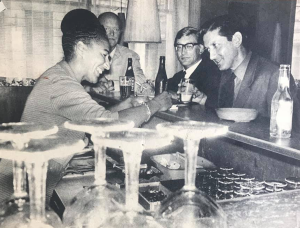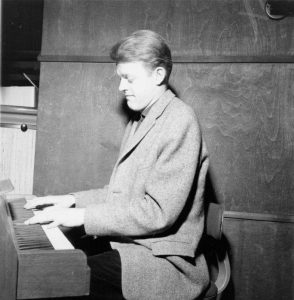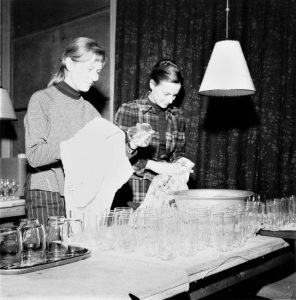SAFE SPACE POLICY
Her på Drop Inn har vi en Safe Space Policy som skal sikre at vi alle bidrager til et inkluderende fælleskab hvor alle kan føle sig trygge og sikre. Det handler om at have det sjovt, danse og føle sig tryg imens.
Derfor forventer vi at vores artister og gæster vil være med til at skabe et rum hvor vi ikke tolerer:
-Sexisme
-Racisme
-Homofobi
-Transfobi
-Aldersfobi
-Vold
-Udskamning
-Verbale krænkelser
-Eller anden diskriminerende adfærd, som kan være med til at skabe et utrygt rum.
Føler du du udsat for-, eller ser andre blive udsat for uvelkommen opførsel så henvend dig til Drop Inn´s personale
og vi vil løse situationen med det samme.
HOSTING & RENTAL
Please click
for more information
CONTACT DROP INN
Please click
for inquiries or questions
OPENING HOURS
Monday – Tuesday 16 – 01
Wednesday 16-02
Thursday 14-02
Sunday open for special occasions
THE FULL STORY.. SO FAR

Drop Inn located in the heart of Copenhagen is a classic venue for intimate live music – more precisely on the corner of Kompagnistræde – Hestemøllestræde, close to the remains of Stone Age villages from the Ertebøllet era from 4,000 years before Christ. Today, the Drop Inn houses not just jazz, but a wide range of musical genres and has become a backstage space for the music scene, mixing with regulars, tourists and bohemians.
Flashback: The iconic Drop Inn opened in 1934 as a traditional restaurant with cabaret entertainment, but found its form when Else Thomsen – flanked by legendary waiters Carl and Herluf and the beautiful Annie Bel-Kher – turned it into a haven for the progressives of the day young, bohemian, actors, musicians, artists and politically committed regulars who enjoyed life to the tune of live jazz music.
Drop Inn was then called “The Red Goat” by the Danish veterans from the Spanish Civil War around the main table and was a breather that welcomed diversity. Back then, people talked about the “death route” or the “elephant walk” to the “elephant graveyard” – where good people from all walks of life commuted from Bobibar and Andy’s to the Drop Inn 24 hours a day until dawn.
Strong characters and legends such as Jørgen and Jytte Ryg, star actresses such as Judy Gringer and Ghita Nørby, the playboy actor Klaus Pagh, artists such as Per Arnoldi and the writer Henrik Stangerup held court, and Stangerup stated: “you have an interview at Drop In – then you leave and when you come back the conversation just continues”. Writer Bent Zinglersen described the Drop Inn in 1965: “The walls are hung with posters, especially from art exhibitions – Picasso, Kandinsky, Klee, Freddie and graphics from the Louisiana Art Museum.” The audience is mainly people interested in art, jazz and subjects like the Campaign against Nuclear Weapons.”
A typical day started with the regulars gathering around 10 in the morning. At 5-6pm the “dinner gang” arrived and often stayed and ate roast beef when the music started playing. Later in the evening the “cultural elite” arrived and partied all night. Perhaps Denmark’s biggest rock band Gasolin also played secret concerts before their tours at Drop Inn.
Bar life in inner Copenhagen is depicted in Morten Vammen’s “Tilt”, Hans Scherfig’s “The Dead Man”, Ole Bas’s “Henne hos Carl og Herluf” and Tom Kristensen’s “Hærværk” – there are many similarities with the description of Ole Jastrau’s deroute at Café des Artistes. At Drop Inn, Jastrau was just called Jurij Moskvitin, who was also part of the court around Simon Spies when they experimented with nitrous oxide.
The colorful cultural elite of the time mingled with originals and regular customers such as Birgit Brüel, the writer Susanne Krage, the model Lise Prahm, Pappa Bue, “Palle Leverpostej”, “Makrellen”, “Smukke Arne”, the journalist Jens Kerte, the film director Ole Roos, the manufacturer Plastik Ole, Painter Jørgen,” Peter Hedegaard, Jørgen Saabye, filmmaker Jesper Høm, war reporter Jan Stage, cartoonist Jørgen Saabye, editors Bent Juhl & Jørgen Grunnet, painters Bent Galatius, Frantz Mikkelsen and Boye Willumsen, architects Kosty and Bjørn Bamse Faber, hippie poet Sigvaldi and his pram with books, the pop artist Per Arnoldi and a trio consisting of the writer Henrik Stangerup, the Brazilian Fausto Wolff and Jurij Moskvitin (pianist, composer, philosopher, mathematician, journalist, writer and bohemian), who always had big plans.
The trio managed to realize the Erasmus Montanus film ‘The Earth is flat’ after a year-long brainstorm in Drop Inn’s smoke clouds, which triggered 1.2 million from the Film Institute – that day the party was a little wilder at the main table, it degenerated into a strip show for the bright morning, where the trio both refused to pay and to end the party – so they ended up staggering home naked in the morning sun. The next day, a runner from the film company came and collected the trio’s clothes and paid the bill. “You mustn’t be sloppy with your life” was the trio’s mantra for the trio – but that was exactly what they did with wine and calvados in conflicting streams. It is also said that a large part of the million dollar budget was drunk before the first recording hit the box office in Brazil. When the film finally premiered, reviews were negative. Audience-wise, the film was a complete failure. It was screened at the 1977 Cannes Film Festival and the French reviews were favorable. Later in the year, it was successfully screened in Brazil, while the guests at the Drop Inn continued to party.
When Copenhagen’s jazz festival started, Drop Inn naturally became a permanent focal point every July – later winter jazz was added, which Drop Inn dedicates itself to every February. In addition, there are a number of long-standing traditions, including beat legend Stig Møller’s monthly concert and open jam sessions every Tuesday and Wednesday.[/vc_column_text][/vc_column][/vc_row]




